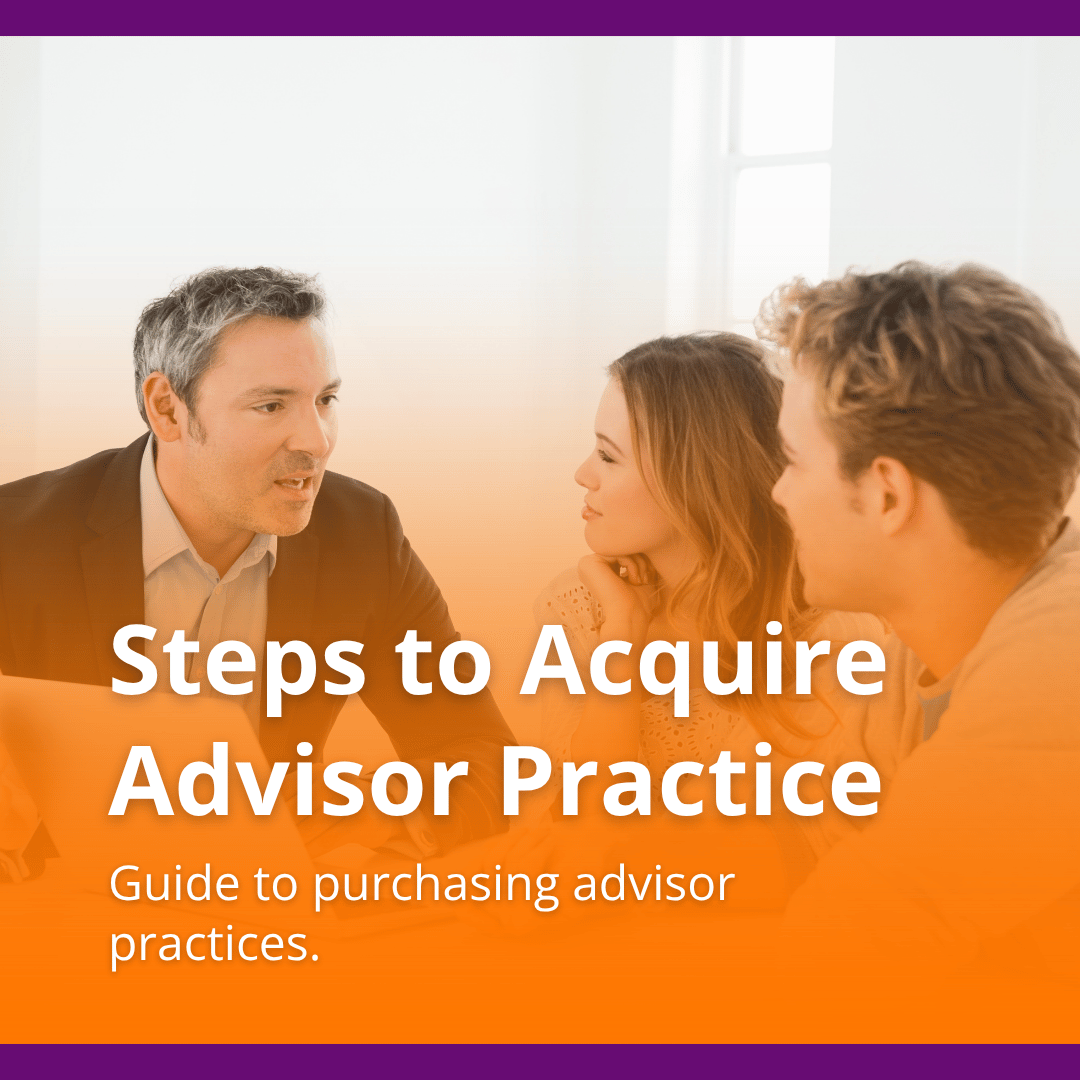Thinking of Selling Your Business? Document Your Operations First
Running a business means knowing every moving part. But to a buyer, that knowledge means nothing if it isn’t documented. And that’s a...
Comprehensive, data-driven valuations and comparative equity analyses to accurately price your practice, establish market benchmarks, and support informed decision-making.
Comprehensive M&A guidance encompassing deal structuring, negotiation strategies, market listings, and transaction closings.
Comprehensive systems, targeted coaching, and in-depth assessments designed to optimize operational efficiency and enhance advisory team effectiveness.
Strengthen continuity through the implementation of formal continuity agreements, the establishment of legal entities, execution of enforceable legal contracts, and securing appropriate capital resources.
11 min read
 Todd Doherty
June 30, 2025
Todd Doherty
June 30, 2025

Why are so many advisors shifting their growth strategy toward acquisitions?
Recent research from Cerulli shows that 48% of financial advisors are open to buying a practice. Of those, 19% are actively looking for acquisition opportunities, while another 28% are interested but not yet searching. This growing interest reflects how advisors are rethinking time, growth, and client acquisition. Buying an existing financial advisor practice offers immediate access to revenue, infrastructure, and a built-in client base, without the slow ramp-up of building from scratch.
This increase in demand is meeting a steady supply of practices for sale, driven by advisor retirements and the need for succession planning. But a successful acquisition requires far more than identifying a practice for sale. Advisors must evaluate client retention risk, validate revenue, assess cultural alignment, and approach due diligence with a disciplined approach.
For those prepared to execute with focus, buying a financial advisor’s book of business presents a direct path to scale with less volatility and stronger revenue continuity. This guide provides a comprehensive roadmap for acquiring an advisory practice, from initial self-assessment to the final handshake. We will explore the critical steps involved to equip you with the knowledge needed to make a successful purchase.
Acquiring an existing financial advisory practice is a powerful growth strategy that offers numerous benefits over starting from scratch. This approach provides a clear path to not only increasing revenue and assets under management but also to enhancing your service offerings and building significant long-term business value.
Acquiring an existing financial advisory practice provides immediate access to a full book of business, which is a primary advantage over organic growth. This translates directly into predictable, recurring revenue streams and a substantial increase in your assets under management (AUM) from day one. For any advisor looking to scale quickly, this infusion of clients and revenue can immediately impact top-line revenue and advisor compensation. It allows you to bypass the years of prospecting and uncertainty involved in building a client base from the ground up.
An acquisition presents a strategic opportunity to add new advisory specialties to your firm's offerings. You might purchase a practice with established expertise in areas like tax planning, complex retirement strategies, or high-net-worth estate management. Integrating these new services broadens your overall value proposition, making your firm more attractive to a wider range of potential clients. This diversification of your service model strengthens your market position and creates new avenues for revenue generation within your expanded client base.
For financial advisors with a long-term perspective, buying another practice is a powerful move to build enterprise value. The increased scale, profitability, and diversified client base make your own firm more valuable and attractive to future buyers. This enhances your own succession options when you eventually decide to sell. Successfully integrating another book of business gives you the chance to demonstrate a capacity for growth and management that significantly increases the market value of your own advisory practice.
Purchasing an established practice can lead to a better work-life balance by allowing you to leverage existing infrastructure and support systems. You are not just buying clients; you are often acquiring proven workflows, technology, and a trained support staff. This established operational framework can absorb much of the administrative burden, freeing you up to focus on high-value activities like client strategy and relationship management. This efficiency allows you to manage a larger business without a proportional increase in your personal workload.
For a new advisor or one who is transitioning their business model, buying a book of business can jumpstart a career in a way that is otherwise difficult to achieve. It provides an instant foundation of clients and revenue that might take a decade or more to build organically. This immediate market presence lends credibility and momentum, allowing you to establish yourself as a significant financial professional in your community much faster. It is a definitive way to accelerate your professional journey and achieve your long-term goals sooner. Realizing these profound career advantages begins with a rigorous assessment of your own preparedness.
Before you begin the search to find a financial advisor practice for sale, a thorough internal assessment is crucial. This foundational step ensures you are prepared for the financial, operational, and personal commitments required for a successful acquisition. A clear understanding of your capacity will guide your search and prevent you from pursuing opportunities that are not a good fit for your current situation. Many advisors think the primary factor is capital, but operational readiness and personal bandwidth are equally important for a smooth transition and long-term success.
The first area of review is your financial state. Determine how you will fund the purchase, whether through personal capital, a business loan, or seller financing. You must assess if you can comfortably afford the down payment required for an acquisition loan without jeopardizing your personal financial stability or the liquidity of your existing practice. Lenders will scrutinize your financial performance and credit history. It is also crucial to project your cash flow after the acquisition. Will the incoming revenue from the acquired book of business be sufficient to cover any debt service and operational costs, especially during the initial transition period when some client attrition is possible? Planning for potential revenue gaps is a sign of a well-prepared buyer.
Beyond the numbers, you must evaluate your firm's operational readiness. Can your current infrastructure, including your CRM, portfolio management software, and compliance systems, absorb a significant influx of new clients and data? Your team is another critical component. Are your existing staff members prepared for the increased workload associated with onboarding, servicing, and reporting for a new client base? An acquisition is not just about the advisor; it affects every level of the organization. You must also honestly assess if you are personally ready to manage a larger and potentially more complex book of business. The demands on your time and leadership will increase substantially, and being prepared for this shift is vital.
Once you identify a potential financial advisor practice for acquisition, the due diligence phase begins. This is a meticulous investigation into every facet of the business to verify the seller's claims and identify any potential risks. Rushing this step or cutting corners can lead to significant problems after the sale is complete. A comprehensive due diligence process protects you from overpaying and ensures the firm you’re buying aligns with your strategic goals and professional standards. Think of it as looking under the hood to ensure the engine is sound.
A thorough review of financial records is the cornerstone of due diligence. Your primary goal is to validate the gross and recurring revenue sources claimed by the seller. Scrutinize financial statements, tax returns, and fee schedules to understand the stability and quality of the revenue. It is important to differentiate between one-time project fees and ongoing advisory fees. You must also gain a clear picture of the practice's profitability by analyzing margins, overhead, and all operating costs. This includes core overhead such as salaries, rent, technology, and marketing, plus any other recurring obligations that affect profitability. Finally, confirm that the valuation is accurate and based on recognized industry methods. It may be wise to commission your own independent valuation to ensure the purchase price is fair and justifiable.
An advisory practice is built on relationships, making client evaluation a critical piece of due diligence. Review the seller’s service model, noting the frequency and nature of client engagement. Are clients accustomed to quarterly meetings, or is contact less frequent? Understanding the existing client service standards will help you anticipate their expectations. Analyze the demographic and generational mix of the client base. A practice with an aging client base may present different risks and opportunities than one with younger clients. The ultimate goal is to assess the likelihood of client attrition post-sale. Strong, trust-based relationships are more likely to transfer successfully, so look for evidence of high client satisfaction and loyalty.
If the practice you are considering buying has employees, evaluating the team and the firm’s culture is essential. Whenever possible, arrange to meet the key team members who would be joining your organization. A stable, experienced team can be a tremendous asset during the transition and beyond. Inquire about employee turnover rates and try to gauge team morale. High turnover could be a red flag indicating underlying issues. More subjectively, consider the alignment of values and philosophies. A mismatch in culture between your existing firm and the one you’re buying can create friction and disrupt the integration process.
A comprehensive review extends to the operational and legal infrastructure of the financial advisory practice. Examine the technology stack, including the CRM, financial planning software, and portfolio management systems. Assess their modernity, efficiency, and whether they are compatible with your own systems. Cybersecurity protocols and data protection measures are also critically important. You should also conduct a thorough compliance review, examining the firm’s Form ADV, historical audit results, and any past or pending litigation or regulatory actions. Lastly, review all material contracts, including office leases, vendor agreements, and any employment contracts, to understand the obligations you would be assuming.
Finding the right advisory practice to acquire requires a proactive and multi-channel approach. Opportunities are not always publicly advertised, so combining traditional search methods with strategic networking can uncover the perfect fit for your growth objectives. Many advisors looking to sell prioritize finding a buyer who will be a good steward for their clients, making relationship-building a key part of the search process. Whether you are a new advisor or an established one, these methods can help you land a business.
A logical starting point is to explore established online marketplaces and deal platforms dedicated to the financial advisory industry. Websites like FP Transitions, AdvisorBid, and Succession Link are popular hubs where a seller can list their practice for sale. These platforms allow you to filter opportunities by AUM, location, revenue, and other key metrics. They provide a structured environment for initial discovery and often include preliminary information and valuation details. While these listings are a great resource, they can also be competitive, so being prepared to act decisively is important when you find a book of business for sale that meets your criteria.
Do not overlook the opportunities within your own professional ecosystem. Your broker-dealer or Office of Supervisory Jurisdiction (OSJ) often has internal listings or may be aware of advisors within the network who are contemplating retirement or selling their practice. They have a vested interest in retaining assets and can be valuable matchmakers. Similarly, if you are part of a larger Registered Investment Advisor (RIA) enterprise, tap into the corporate network. These organizations frequently facilitate internal succession plans and acquisitions to promote growth and continuity among their affiliated financial professionals.
Some of the best acquisition opportunities are not officially for sale. You can identify potential sellers through direct prospecting. This can involve a targeted direct mail campaign to advisors in your desired geographic area who are approaching retirement age. Craft a professional and confidential letter expressing your interest in buying a financial advisory practice. You can also use your professional network, including attorneys, accountants, and wholesalers, to identify advisors who might be looking to sell. Let your contacts know you are actively looking to buy a practice; you might be surprised by the leads that surface through word-of-mouth.
There is no substitute for face-to-face interaction when building the relationships that can lead to a successful acquisition. Attending advisor events, industry conferences, and study group meetings provides invaluable networking opportunities. These settings allow you to connect with peers and learn about off-market opportunities. Engage in conversations with succession-minded advisors. Building a rapport over time can position you as a trusted potential buyer when they decide it is time to sell their book of business. Many advisors who buy practices find their ideal fit through connections made at these industry gatherings.
Once you have completed due diligence and are confident in your choice, the next phase is to structure the acquisition and meticulously plan the transition. This stage is where the legal and financial details are finalized, and the roadmap for merging the two practices is created. A well-structured deal protects both the buyer and seller, while a thoughtful transition plan is paramount for client retention and operational continuity. It is about integrating the acquired practice without disrupting the client experience.
The purchase agreement is the legally binding document that outlines the terms of the sale. It is highly recommended that you engage legal and valuation experts who specialize in advisory transactions to help you shape the terms. The agreement should clearly define the purchase price, payment structure, and what assets are included in the sale. Crucially, it should also include clauses that protect you, the buyer. These might include client attrition protections, where a portion of the purchase price is held back or adjusted if client retention falls below a certain threshold within a specified period. Financing clauses that make the deal contingent on securing adequate funding are also standard.
A seamless transition is the key to retaining clients and staff. The handover process should be a collaborative effort between you and the selling advisor. Joint introductions to the client base are highly effective for building trust and demonstrating continuity. A gradual transition, often taking place over a period of 6 to 18 months, allows clients to become comfortable with you before the selling advisor fully exits. This timeline enables a smoother transfer of knowledge and relationships. A similar approach should be taken with staff, ensuring they feel secure and valued throughout the process.
The goal of the integration phase is to merge the two businesses with minimal disruption to client service. This involves carefully aligning client service schedules and communication protocols. For the first several months, it is often wise to maintain the workflows and communication styles that clients are accustomed to. Consistency is key to preventing client anxiety. Over time, you can gradually introduce your own processes and systems. Branding and compliance updates should also be handled thoughtfully, with clear communication to clients about any changes they will see.
The acquisition of a financial advisory firm is a complex legal transaction. It is imperative to get legal advice from an attorney who has specific experience with M&A in the financial services industry. A general business lawyer may not be familiar with the unique regulatory and compliance nuances of an advisory practice sale. An experienced M&A attorney will help you navigate the intricacies of the purchase agreement, review all contracts, advise on deal structure, and ensure the entire transaction adheres to all applicable laws and regulations. This investment in specialized legal counsel is a critical safeguard.
While buying a financial advisory book of business can significantly accelerate growth, the process is not without its challenges. A prudent buyer must be aware of the potential risks and develop strategies to mitigate them. Acknowledging these issues upfront allows for better planning and reduces the likelihood of negative surprises after the deal is closed, as a successful acquisition depends on a clear-eyed assessment of what could go wrong.
One of the most significant risks is the potential loss of key people during the handoff. Even with a well-planned transition, some clients may not feel a connection with you and choose to leave, impacting revenue. Simultaneously, staff departures or cultural conflict can pose a serious threat to continuity. If essential team members leave, you could lose valuable institutional knowledge, while a clash between firm cultures can lead to low morale and operational inefficiency.
Financial risks are prominent in any acquisition. There is always the possibility of overpayment, where the price paid for the practice fails to generate a sufficient return on investment. This often happens when due diligence is inadequate or revenue projections are too optimistic. A subsequent revenue dip due to poor transition planning is another common issue, especially if the changeover disrupts client billing or the expected cadence of service delivery.
A thorough due diligence process must focus on uncovering potential compliance surprises, which can be costly and damaging to your reputation. Undisclosed regulatory issues or a history of compliance breaches from the seller’s practice can become your problem after the acquisition is finalized. You are not only buying the assets of a firm but also inheriting its regulatory standing, making a clean compliance history a critical factor.
Perhaps the most subtle risk is unintentionally buying a "job" instead of a scalable business. This occurs when the acquired practice is heavily dependent on the selling advisor and lacks documented systems and processes. If all client relationships and operational knowledge reside solely with the seller, you may find yourself overwhelmed and unable to achieve the strategic growth you envisioned once they have exited.
Buying a financial advisor practice is a transformative move that can position you for a higher income, enhanced succession options, and stronger long-term enterprise value. The journey to acquire a book of business is a substantial undertaking that requires careful planning, rigorous due diligence, and a clear vision for the future. It is a business investment that demands strategic thinking and objective analysis rather than an emotional leap. Success is found in the details of the valuation, the thoroughness of the review, and the careful management of the client and staff transition. When done correctly, the acquisition of an existing financial practice is one of the most effective ways to build a leading advisory firm.
If you are considering buying a financial advisory practice, you do not have to navigate the process alone. The complexities of finding the right fit, performing due diligence, and structuring a favorable deal require specialized expertise. At Advisor Legacy, we focus on helping financial advisors like you achieve their growth objectives through strategic acquisitions. We can help you clarify your goals, identify ideal targets that match your budget and vision, and assess your overall M&A readiness. Let our experience guide you through this critical career move.
Schedule a buyer strategy call with Advisor Legacy to take the next step toward your future.
Todd Doherty serves as Vice President for Advisor Legacy, where he leads advisors through the full M&A lifecycle—readiness, valuation analysis, buyer/seller matching, due diligence, and post-close integration. With more than 15 years in senior roles at financial advisory firms and hands-on ownership experience, Todd brings an operator’s lens to every engagement. His writing focuses on practical ways to boost enterprise value, structure win-win deals, and avoid execution risk. Todd collaborates closely with the firm’s valuation, lending, and legal partners to help advisors make confident, data-driven decisions.
Receive timely articles, tip sheets, events, and more right in your inbox.

Running a business means knowing every moving part. But to a buyer, that knowledge means nothing if it isn’t documented. And that’s a...

Growing by acquisition is one of the fastest ways to scale — but it’s also one of the easiest ways to stumble. Behind every successful deal is a...

The M&A landscape in financial services isn’t slowing down. It’s evolving. Fast. As of mid-2025, deal values in the sector have surged by...